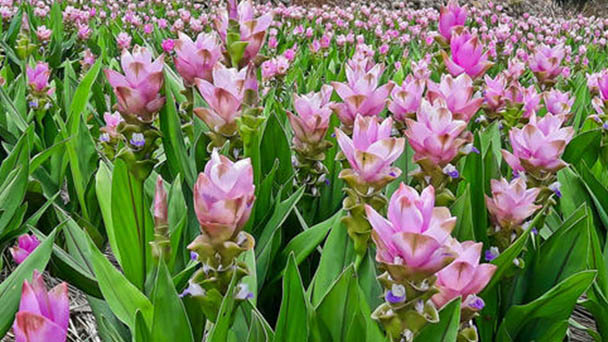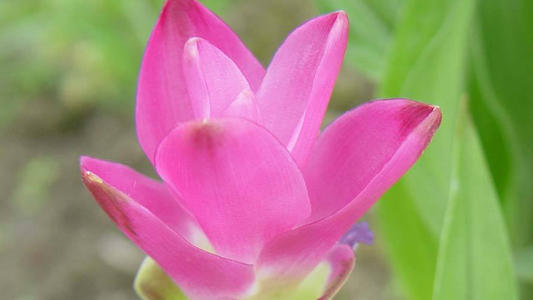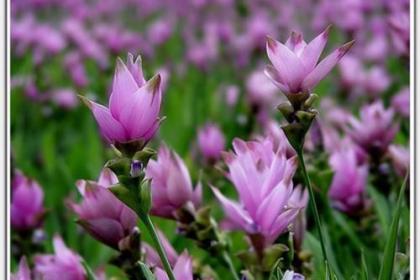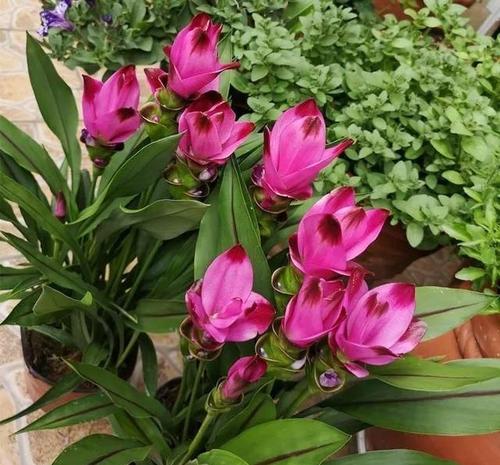Siam tulip profile
Written by Maggie
Sep 18 2021

Siam Tulip (Curcuma alsimatifolia) belongs to the genus Curcuma in the Zingiberaceae, is a perennial herbaceous tropical bulbous flower, originally produced in Chiang Mai, Thailand. Siam Tulip is very popular in Japan and Taiwan because of its unique flower pattern, bright color and long flowering period. At present, the mainland market is almost blank, and the market prospect is very promising.
Siam Tulip picture

Morphological characteristics of Siam Tulip
The leaves of Siam Tulip (Curcuma alsimatifolia) are long elliptical, midrib purplish red. The inflorescence of siam tulip is spiked, and the upper end of the pedicel is covered with 7-9 semicircular green bracts, followed by 9-12 broad oval pink bracts with bright color. These pink bracts are shaped like the corolla of lotus, which are the main places for ornamental. Pink bracts are with green spots at the tip of cultivars. The true flowers of the Siam tulip are borne in the lower half of the inflorescence, each bearing four small flowers. The floret has a labulate corolla with 3 outer petals and 3 inner petals; One of the inner petals of the labellum is purple, and the funnel-shaped center of the labellum is yellow. When the flower bud of the terminal bud differentiates and blossoms, the base of the stem gradually becomes hypertrophic, forming a new corm of spherical shape to conical shape. At the base of the new corm, the root tips of the vegetative roots, which are taproot-shaped, gradually become hypertrophic after autumn, forming the spherical storage roots and forming the new seed bulbs. The main cultivars are "Chiang Mai Powder" and "Holland Red".
The bulbs of Siam Tulip (Curcuma alsimatifolia) consist of globular to conical bulbs (or rhizomes) and storage roots (or milk cans) at the base of the bulbs. One bulb can bear 1 to 6 bulbs
Unequal storage roots are with two rows of opposite buds on the corm, but usually only one first-generation bud sprouts from a corm after spring planting. After the new bud germination, the leaves begin to stretch, and then the inflorescence develops, and the pedicels grow and bloom. The cut flowers of Siam Tulip are about 40-60 cm in length when grown in the open air and over 70 cm if shaded.
The leaves of Siam Tulip (Curcuma alsimatifolia) are long elliptic, midrib purplish red. When cultivated in the open air, the average leaf length is about 30 cm, the width is about 5 cm, and generally shorter than the flower stem. But under shade cultivation, the leaves are relatively narrow, up to 45 cm in length, sometimes even longer than the flower stem.
After germination, the new buds of Siam Tulip grow first downward and then upward, and the leaves are extracted. After the germination of the first generation of buds, the second generation of buds have been unearthed from the base of the first generation of buds. And so on, a third generation of buds sprout from the second generation, and a fourth generation sprout from the third generation.Good fertility can multiply in the same year
It is derived from 5-6 generations, but the new buds that can blossom in that year are about 1-3 generations. Siam Tulip fresh cut flowers can last about 14 days under the right conditions, and its potted flowers can last up to 3 months under the right conditions.
After the bulb planting of Siam Tulip (Curcuma alsimatifolia), fibrous absorptive roots first sprouted from the base of the storage roots, then sprouted from the buds on the corm, and two different root groups sprouted from the base of the new buds. One was fibrous absorptive roots, and the other was vegetative roots with straight roots. The fibrous and rootlike absorbent roots wither after dormancy, while the root tips of the taproot tropic vegetative roots will gradually become hypertrophic and form spherical storage roots after autumn, which will always grow on the corm and not wither due to dormancy of the aboveground parts.

Siam Tulip growing environment
Siam tulip (Curcuma alsimatifolia) grows strongly and has strong adaptability to the soil. Generally, it can be planted in the soil that is not too viscous. However, if it is professional planting, in order to take into account the harvesting of the seed balls, it is more suitable to choose sandy loam soil with deep soil layer, good drainage and no water shortage.
The optimal germination temperature for siam tulip bulbs is 30-35℃. If dormant and awakened bulbs are placed at a constant temperature of 30℃ for germination, germination will start in about 25-30 days, and it will take about 40-50 days to germinate completely. Plant in the field after 3 months. It will take about 35-60 days from planting to germination, depending on the planting period and soil temperature and moisture management after planting. In the growing season, it likes warm and humid, sunny weather. In minnan every early November, due to the temperature decrease and sunshine become shorter, Siam tulip growth is blocked, the old leaves start yellowing, pulled out of bud bracts small, thin, design and color is lighter, most appear deformity, quickly reduce yields at the same time, to the end of November, blade is dried up, and the growth of aboveground part, come to a complete stop of the underground bulb into a dormant state.
Siam Tulip distribution range
Siam Tulip (Curcuma alsimatifolia) was originated in Chiang Mai area, Thailand, for our country's new introduction of flower rice varieties.
Siam Tulip propagation methods
Siam Tulip (Curcuma alsimatifolia) is commonly used to divide the propagation method. When the sunshine duration is shorter (less than 13 hours), the temperature is cooler (less than 15℃), after the storage root hypertrophy, the aboveground plants gradually dry up and enter hibernation, then the seed bulbs can be harvested. After excavation, the pellets are picked out manually, then separated, cleaned and disinfected.
Siam Tulip main value
Cut flowers: Siam Tulip (Curcuma alsimatifolia) itself is a popular cut flower material in the world.
Potted flowers: Siam Tulip (Curcuma alsimatifolia) is suitable for potted flowers.
Flower beds: Siam Tulip (Curcuma alsimatifolia) varieties are suitable for this type of application. If 'Chiang Mai powder' and 'Red Guanyin' are planted in places with weak light, dwarfing agents can be applied appropriately to shorten and coarser flower stems to increase lodging resistance.
Sacrifice: Siam tulip is also often used as a flower to worship the gods and Buddha.

Latest Updated
- Benefits of Bugleweed - 7 Science-backed Health Benefits
- Bugleweed Dangers & Side Effects - Is It Poisonous?
- How to Plant Evergreen Trees - What You Should Know
- When to Plant Evergreens - Grow Guide for Evergreen Trees
- 12 Wonderful Evergreen Shrubs for Your Garden
- 12 Popular Evergreen Plants with Pictures for Beginners
- When And How To Prune A Lilac Bush Like a Pro
- How to Grow & Care for Lilac Vine (Hardenbergia Violacea)
- Japanese Lilac Tree (Syringa Reticulata) Care & Propagation Guide
- Shumard Oak Pros and Cons - What to Know
Popular Articles
- Winter maintenance of Antirrhinum Majus
- How to Grow Terminalia Mantaly Tree
- How to Grow and Care for Crossostephium Chinense
- How to grow Antirrhinum Majus in spring
- Peristeria Elata (Dove Orchid) Profile: Info & Care Guide
- Underwatered Snake Plant (Sansevieria Trifasciata) - Signs And How To Fix
- How to Care for Brazilian Jasmine Plant (Mandevilla Sanderi)
- How to Grow & Care for Graptopetalum Purple Delight in Summer
- Rosa Chinensis (China Rose): Plant Growing & Care Tips
- How to Care for Baby Sun Rose (Aptenia Cordifolia)